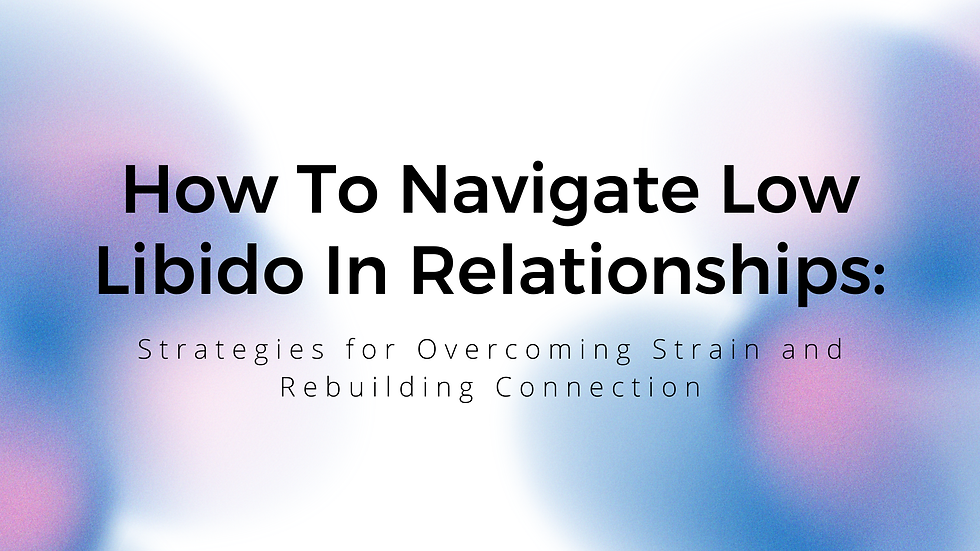Sensate Focus: Reclaiming Pleasure Without Pressure
- Maddie Hundley
- Feb 1
- 3 min read
Updated: Sep 29
Let’s talk about intimacy. Not the version frequently shaped by mainstream media, self-help books, or the relentless pressure to “keep the spark alive,” but the kind that actually honors your body, your boundaries, and your own relationship to touch.
If intimacy has ever felt like a chore instead of an experience, you’re not alone. A lot of us, especially queer folks, trauma survivors, and those living in marginalized bodies, have been taught that pleasure is something we owe rather than something we own.
That’s where sensate focus shifts the conversation. This practice offers a way to explore yourself, challenge expectations, and improve performance. It’s a guided process of exploring sensation without worrying about where it leads, whether you’re “doing it right,” or whether your body is responding in ways you think it should.
Why Sensate Focus?
Many of us have been trained to think of intimacy as something transactional – something to give, prove, or accomplish. That’s especially true if you’ve ever been told that:
• Desire should be automatic, or else something is wrong with you
• Sexuality has to look a certain way to be valid
• Your worth in relationships is tied to what you can offer physically
For BIPOC communities, queer people, disabled folks, survivors, and anyone whose body has been scrutinized or controlled, these messages are pervasive. Sensate focus moves intimacy out of obligation and back into a place of curiosity and consent.
A Sensate Focus Exercise
If you’re looking for a way to reconnect with your body or partner(s), this exercise is a great place to start. It’s about noticing, not performing. It’s about staying curious and challenging yourself to begin staying present.
Step 1: Establish Safety and Choice
• You get to decide what feels good for you. If touch doesn’t feel right, start with breath, warmth, or holding an object with texture.
• This doesn’t have to be sexual. It can actually be helpful to start with your neutral zones like your arms, hands, shoulders, or back.
• If solo or partnered, set a mutual agreement: this is exploration, not foreplay. There is no “next step.”
Step 2: Set Up Your Space
• Choose somewhere quiet, comfortable, and free from distraction.
• Adjust lighting, sound, and temperature in ways that support relaxation.
• If solo: Take a moment to ground yourself through deep breaths, stretching, or whatever way you feel most centered.
• If partnered: Take a few moments to breathe together before starting.
Step 3: Engage With Touch at a Slow, Intentional Pace
• If solo: Explore touch on your own terms. Glide your fingertips across a part of your body, apply light or firm pressure, or notice how different textures feel against your skin. Focus on sensation without needing to judge it.
• If partnered: One person gives touch, the other(s) receive.
o The giver uses gentle, exploratory movements—tracing fingertips, applying light or firm pressure, using different parts of the hand to create different sensations.
o The receiver(s) only focuses on what they feel without pressure to react or reciprocate.
There is no “right way” to experience this. Whether it feels soothing, strange, neutral, or even frustrating, all responses are valid.
Step 4: Reflect Without Judgment
• When you’re done, pause and notice any sensations or emotions that came up.
• If solo: Journal or think about what stood out. What textures or pressures felt grounding? Did any sensations surprise you?
• If partnered: Share a few observations – not critiques, not expectations. Just what you noticed. Take turns sharing or reflect individually before coming together to discuss if that feels right.
• If discomfort arose, that’s okay. It can take time to unlearn performance-based intimacy, and everyone’s experience will be different. Allow yourself and your partner(s) space to process in whatever way feels best.
What Sensate Focus Can Offer You (And What It Can’t)
This isn’t a magic solution. It won’t override trauma, eliminate body discomfort overnight, or instantly “fix” mismatched desire. What it does do is help reclaim intimacy from rigid expectations and reminds us that touch, closeness, and pleasure belong to us – not to performance, not to partners, not to anyone else’s ideas of how we “should” experience them. You don’t owe anyone access to your body. Connection is not a transaction, and your worth is not measured by your willingness to give. 💛 At Zillennial Intimacy, we offer sex therapy and intimacy coaching to help individuals and couples rebuild trust, communication, and desire in a safe, affirming space. Click here to learn more or book a session. You don’t have to navigate this alone—support is here when you’re ready.
By Alex Whitman, MA
@zillennial.intimacy




Comments